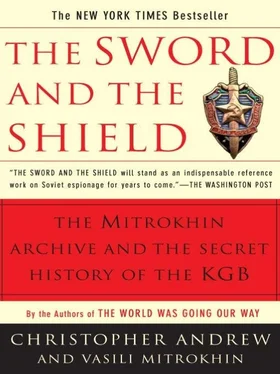The arms supplied to Haddad consisted of 50 West German pistols (10 with silencers) and 5,000 rounds of ammunition; 50 captured MG-ZI machine guns with 10,000 rounds of ammunition; 5 British-made Sterling automatics with silencers and 36,000 rounds of ammunition; 50 American AR-16 automatics with 30,000 rounds of ammunition; 15 booby-trap mines manufactured from foreign materials; and 5 radio-controlled SNOP mines, also assembled from foreign materials. The two varieties of mine were considered some of the most sophisticated small weapons in the Soviet arsenal, and, like some of the silencers given to Haddad, had never previously been supplied even to other members of the Warsaw Pact. The SNOP mines could be detonated by radio signal at distances of up to two kilometers in cities and fifteen to twenty kilometers in the countryside.
The successful completion of operation VOSTOK was greeted in the Centre as a major triumph. On the recommendation of the FCD, and with the approval of Rear Admiral Radchenko, head of the KGB Special Department in the Pacific Fleet, VOSTOK souvenirs (each valued at 600 roubles) and cash bonuses of 600 roubles were awarded to seven of the naval commanders who had taken part: Captain V. P. Lebedev, commander of the Kursograf; Captains (First Rank) A. G. Shtyrov and E. P. Lopatin; Captains (Second Rank) G. S. Babkov and V. I. Avramenko; and Lieutenant Commanders A. V. Garnitsky and A. S. Klimchuk. The Centre also sent a formal letter of thanks to the Chief of Naval Staff, Admiral of the Fleet N. D. Sergeyev.
The Centre was to make what it considered successful use of Haddad and the PFLP in a number of special actions in the Middle East, particularly against Israel (which will be covered in the next volume of this book). But operation VINT, the attempt by the PFLP to abduct the deputy head of the CIA station in Beirut, ended in failure. VIR varied his daily routine and Haddad’s gunmen found it impossible to implement the original plan for his abduction. During 1971 Department V devised a number of alternative plans to kidnap VIR. One simply proposed that Haddad arrange VIR’s assassination. All failed. So did operation INTIKAM, an attempt to use PFLP terrorists to kill two Soviet defectors, P. S. Branzinkas and his son (codenamed PIRATY, “Pirates”), who in 1970 hijacked an Aeroflot aircraft and escaped to Turkey. The operational file records that NATSIONALIST did not realize how difficult the assignment would be, and overestimated his capabilities.” 38
Plans to make larger use of the PFLP to hunt down Soviet defectors were largely abandoned. Andropov’s decision to use Haddad for special actions, and Brezhnev’s approval for it, none the less marked a turning point in the history of KGB operations. Henceforth, other Soviet Bloc intelligence services were to follow the Soviet lead in using, or conniving in the use of, terrorist groups. 39
LIKE THE OPERATIONS of the Thirteenth Department during the Khrushchev era, those of Department V were seriously compromised by defections. The most important defector was the Line F officer in the London residency, Oleg Adolfovich Lyalin, an expert in hand-to-hand combat as well as a highly proficient marksman and parachutist who had been recruited by MI5 as a defector-in-place in the spring of 1971. During the six months before he defected in September, Lyalin provided details of KGB sabotage plans in London, Washington, Paris, Bonn, Rome and other Western capitals. In addition to compromising preparations for a number of peacetime special actions, he revealed Department V’s hair-raising contingency plans for operations during periods of international crisis or conflict which would be carried out by illegals, local agents and sabotage and intelligence groups (DRGs) who would infiltrate each target country. 40
In Washington, according to Oleg Kalugin, head of Line PR and deputy resident, Line F “did everything from plotting ways to poison the capital’s water systems to drawing up assassination plans for US leaders.” 41Projected sabotage in Britain included plans to flood the London Underground, blow up the early-warning station at Fylingdale, North Yorkshire, and destroy V-bombers on the ground. Some of Department V’s schemes were as bizarre as any of those devised by the CIA in its unsuccessful attempts to kill Castro a decade earlier. One plan revealed by Lyalin was for KGB agents posing as messengers and delivery men to scatter colorless poison capsules along Whitehall corridors of power which would kill all those who crushed them underfoot. Though the British government released few details about Lyalin after his defection, the Attorney General told the Commons that he was charged with “the organization of sabotage within the United Kingdom” and “the elimination of individuals judged to be enemies of the USSR.”
The Centre was caught completely off-guard by Lyalin’s defection and the almost simultaneous action against the London residency taken by the British government. On September 24, 1971 the Permanent Under-Secretary at the Foreign and Commonwealth Office, Sir Denis Greenhill, summoned the Soviet chargé d’affairs, Ivan Ivanovich Ippolitov (a KGB agent), and informed him that 90 KGB and GRU officers stationed in Britain under official cover were to be expelled and another fifteen, then on leave in the Soviet Union, would not be allowed to return, making a grand total of 105 expulsions. 42Many of the Soviet intelligence officers concerned had been known to MI5 and SIS for some time, but over the past six months Lyalin had confirmed a number of probable identifications and added new names to the list. 43Preparations for operation FOOT, as the mass expulsion was codenamed in Whitehall, had been under secret discussion throughout that time. In a joint memo to the Prime Minister, Edward Heath, on July 30, the Foreign and Home Secretaries, Sir Alec Douglas Home and Reginald Maudling, argued that the sheer numbers of KGB and GRU officers in London were “more than the Security Service can be expected to contain.” 44The horrendous nature of some of the Department V sabotage plans revealed by Lyalin added weight to the arguments for expulsion.
Almost immediately after Ippolitov’s return from the FCO on Friday September 24, the MI5 surveillance team near the Soviet embassy in Kensington Palace Gardens reported that a KGB officer had been seen sprinting across the road from the residency opposite, no doubt summoned by telephone for an urgent briefing on the mass expulsion. 45In the short term Lyalin’s defection probably caused even greater concern than operation FOOT. Over the weekend the Centre informed the Soviet leadership that Lyalin was likely to compromise Department V operations in other countries. On Monday September 27 Brezhnev cut short a tour of eastern Europe for an emergency meeting of the Politburo in the VIP lounge at Moscow airport. Shortly afterwards most Line F officers were recalled from Western capitals, leaving Department V effectively crippled and unable to fulfill its task of coordinating sabotage operations abroad in time of crisis. 46The Centre investigation into the London débécle, which, as was traditional, emphasized the alleged personal depravity of the defector, claimed that Lyalin had seduced the wives of a number of his Soviet colleagues in London, and heavily criticized the former resident, Yuri Nikolayevich Voronin, for covering up Lyalin’s misdeeds to avoid a scandal . 47The head of the FCD Third Department, whose responsibilities included operations in Britain, was among those senior KGB officers who were demoted or sacked as a result. 48
JUST AS STASHINSKY’S defection in 1961 had made the Centre much more cautious in ordering assassinations, so Lyalin’s defection a decade later dealt a further blow to its plans for peacetime sabotage. Department V found itself in limbo pending a reorganization which took three and a half years to complete. The files seen by Mitrokhin record no new schemes for KGB “special political actions” during the few years immediately after Lyalin’s “treachery.” (It is, of course, possible that some special actions are recorded in files not seen by Mitrokhin.) One example of the Centre’s declining enthusiasm for such operations which made a particular impression on Mitrokhin was its response to the defection of another star of the Kirov Ballet, Mikhail Baryshnikov, while on a tour of Canada in June 1974. Baryshnikov’s flawless classical style and apparently effortless grace had made him one of Mitrokhin’s personal favorites. Among the intercepted messages sent to Baryshnikov after his defection which found their way into his KGB file, Mitrokhin noted one from a female balletomane in Leningrad which told him that he “was, is and forever will be my dear little brother… one of the brightest, most beautiful and most notable people I have ever met.” Unsurprisingly, the KGB kept Baryshnikov under close observation after his defection. Its agents included another ballet dancer, codenamed MORIS, who also reported on Nureyev and Makarova. What struck Mitrokhin, however, was the apparent lack of plans to maim Baryshnikov similar to those which had been devised, though not apparently implemented, against Nureyev and Makarova a few years earlier. 49
Читать дальше











